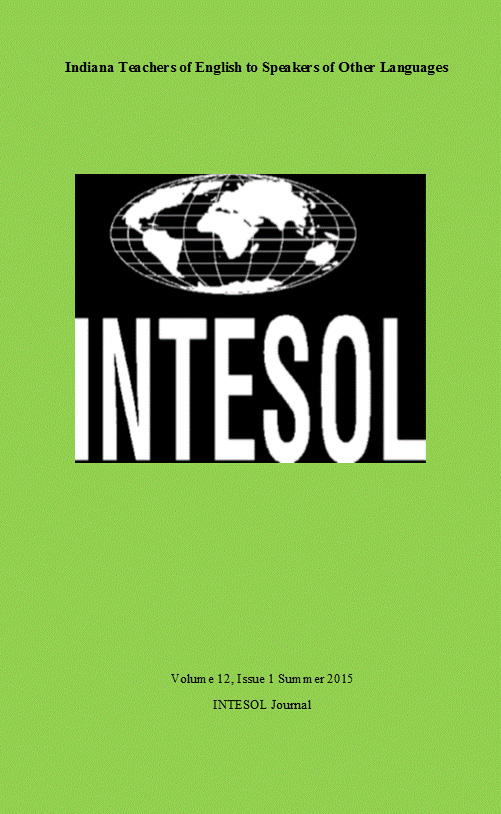Moving on Up with WIDA: Helping Near-Proficient English Learners Reach Full Proficiency
Abstract
Most (48%) of all the English learners (ELs) in the state are at Level 4 or the near proficient level/advanced level. However, there is much consternation that ELs struggle to move to the Fluent English Proficient (FEP) level or Level 5, which is necessary for them to be successful participants in mainstreamed classrooms. Indiana’s recent adoption of the World-class Instructional Design and Assessment (WIDA) standards for ELs is timely because of its focus on two central elements critical for the students’ progression, namely maintaining language and academic achievement simultaneously and the assumption of shared responsibility of ESL and content area teachers in teaching the students. This article revisits teachers’ concerns for Level 4 students and suggests pathways of practice aligned with WIDA’s standards for classroom instruction and professional development.
References
Albrecht, D. (2013, November). Identifying and teaching high ability English learners:
Meeting the needs of an under-identified group. INTESOL Conference. Presentation
conducted from Indiana University Purdue University Indiana, Indianapolis, IN.
Brinton, D. M., Snow, M. A., & Wesche, M. B. (1989). Content-based second language
Instruction. Boston: Heinle & Heinle.
Chamot, A. U., & O'Malley, J. M. (1996). The cognitive academic language learning approach: A model for linguistically diverse classrooms. The Elementary School Journal, 96(3), 259-273.
Davison, C. (2006). Collaboration between ESL and content teachers: How do we know when we are doing it right? International Journal of Bilingual Education and Bilingualism, 9(4), 454–475.
Honigsfeld, A., & Dove, M.G. (2010). Collaboration and co-teaching: Strategies for English learners. Thousand Oaks, CA: Corwin Press.
Echevarria, J. & Graves, A. (2010). Sheltered content instruction: Teaching students with diverse
abilities (4th ed.). Boston: Allyn & Bacon.
Gay, G. (2002). Preparing for culturally responsive teaching. Journal of Teacher Education, 53(2), 106-116.
Gottlieb, M. (2013). Essential actions: A handbook for implementing WIDA’s framework for
English language development standards. Madison, WI: Board of Regents of the
University of Wisconsin System. Retrieved from https://www.wida.us/get.aspx?id=712
Indiana Department of Education (2014). Indiana’s WIDA Implementation Guide for English
Learners. Indianapolis, IN: Office of English Learning and Migrant Education. Retrieved
from http://www.doe.in.gov/sites/default/files/standards/indianas-wida-implementation-guide.pdf
Ladson‐Billings, G. (1992). Reading between the lines and beyond the pages: A culturally
relevant approach to literacy teaching. Theory into Practice, 31(4), 312-320.
Mayville, H. W. (2012). Six traits of writing for English language learners: A guide to effective
writing instruction for low-proficiency ELLs. Charlotte, NC: CreateSpace.
Moll, L. C., Amanti, C., Neff, D., & Gonzalez, N. (1992). Funds of knowledge for teaching: Using a qualitative approach to connect homes and classrooms. Theory into Practice, 31(2), 132-141.
National Governors Association Center for Best Practices & Council of Chief State School
Officers. (2010). Common Core State Standards. Retrieved from
http://www.corestandards.org/assets/CCSSI_ELA%20Standards.pdf
Pawan, F. (2000). Creative problem solving: A webquest for advanced ESL students at the
college level. Retrieved from http://www.usca.edu/education/courses/aete731/ss02/
Trainer/Creative%20Problem%20Solving.htm
Pawan, F. (2008). Content area teachers and scaffolded instruction for English Language
Learners. Teaching and Teacher Education, 24(6), 1450-1462.
Pawan, F. & Ward, B. (2007). Integrated curriculum development through interdisciplinary collaboration between ESL and content area teachers. In F. Pawan & G. B. Sietmann (Eds.). For all our students: Collaborative partnerships among ESL and classroom teachers (pp. 5-30). Alexandria, VA: TESOL.
Pawan, F., & Honeyford, M. (2009). Academic literacy. In R. F. Flippo & D. C. Caverly (Eds.),
Handbook of college reading and study strategy research (2nd ed., pp. 26-46). New York: Routledge.
Pereira, N., & Gentry, M. (2013). A qualitative inquiry into the experiences of gifted English
language learners in midwestern schools. Journal of Advanced Academics, (24)3, 164–194.
Pereira, N., & de Oliveira, L. C. (2015). Meeting the linguistic needs of high-potential English
language learners: What teachers need to know. Teaching Exceptional Children, 47(4),
-215.
Thomas, W. P., & Collier, V. P. (2002). A national study of school effectiveness for language
minority students' long-term academic achievement. Santa Cruz, CA: Center for Research on Education, Diversity, and Excellence, University of California at Santa Cruz.
Windschitl, M. (2002). Framing constructivism in practice as the negotiation of dilemmas: An
analysis of the conceptual, pedagogical, cultural, and political challenges facing teachers.
Review of Educational Research, 72(2), 131–175.


